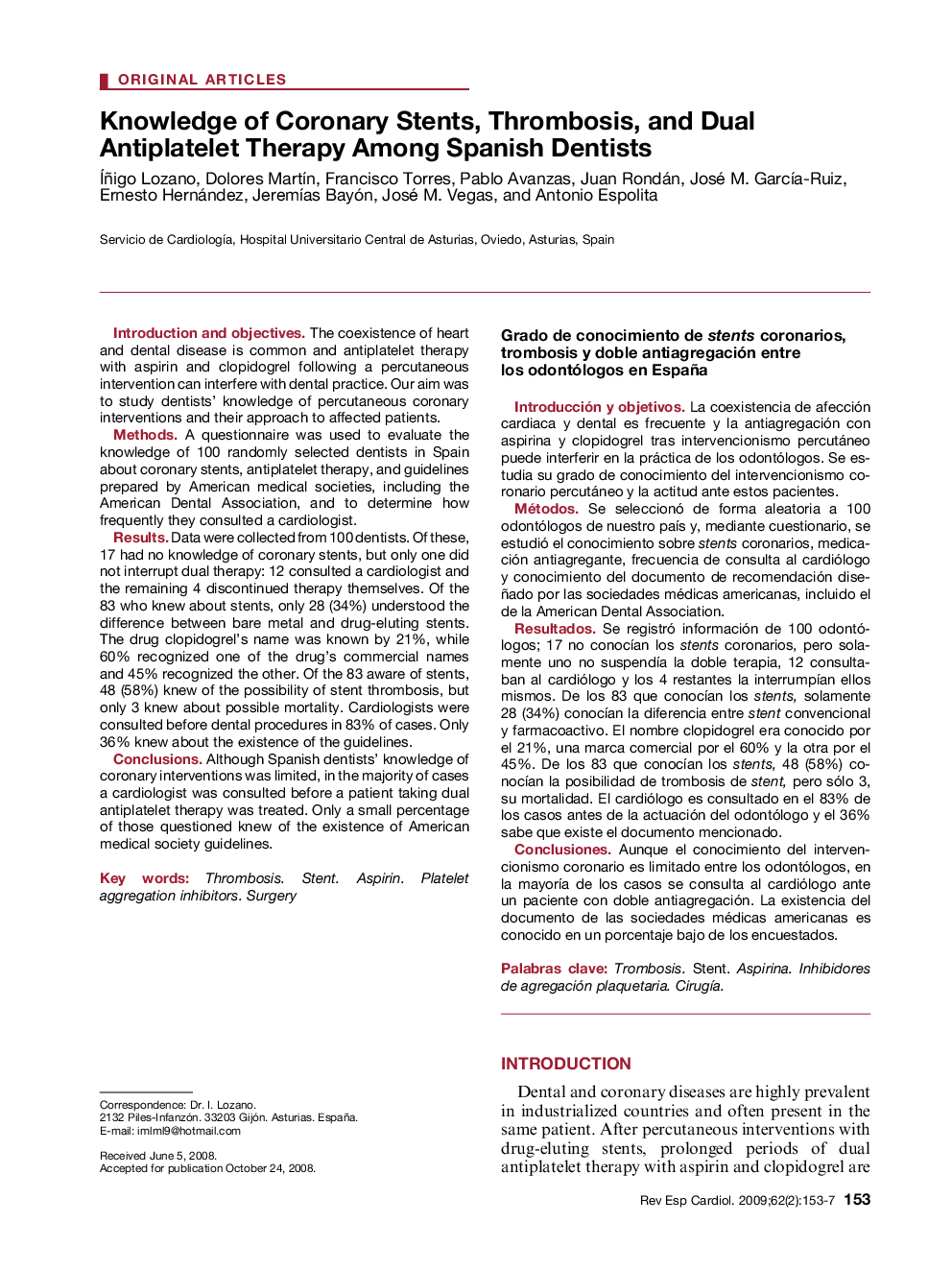| Article ID | Journal | Published Year | Pages | File Type |
|---|---|---|---|---|
| 3019161 | Revista Española de Cardiología (English Edition) | 2009 | 5 Pages |
Introduction and objectivesThe coexistence of heart and dental disease is common and antiplatelet therapy with aspirin and clopidogrel following a percutaneous intervention can interfere with dental practice. Our aim was to study dentists’ knowledge of percutaneous coronary interventions and their approach to affected patients.MethodsA questionnaire was used to evaluate the knowledge of 100 randomly selected dentists in Spain about coronary stents, antiplatelet therapy, and guidelines prepared by American medical societies, including the American Dental Association, and to determine how frequently they consulted a cardiologist.ResultsData were collected from 100 dentists. Of these, 17 had no knowledge of coronary stents, but only one did not interrupt dual therapy: 12 consulted a cardiologist and the remaining 4 discontinued therapy themselves. Of the 83 who knew about stents, only 28 (34%) understood the difference between bare metal and drug-eluting stents. The drug clopidogrel's name was known by 21%, while 60% recognized one of the drug's commercial names and 45% recognized the other. Of the 83 aware of stents, 48 (58%) knew of the possibility of stent thrombosis, but only 3 knew about possible mortality. Cardiologists were consulted before dental procedures in 83% of cases. Only 36% knew about the existence of the guidelines.ConclusionsAlthough Spanish dentists’ knowledge of coronary interventions was limited, in the majority of cases a cardiologist was consulted before a patient taking dual antiplatelet therapy was treated. Only a small percentage of those questioned knew of the existence of American medical society guidelines.
Introducción y objetivosLa coexistencia de afección cardiaca y dental es frecuente y la antiagregación con aspirina y clopidogrel tras intervencionismo percutáneo puede interferir en la práctica de los odontólogos. Se estudia su grado de conocimiento del intervencionismo coronario percutáneo y la actitud ante estos pacientes.MétodosSe seleccionó de forma aleatoria a 100 odontólogos de nuestro país y, mediante cuestionario, se estudió el conocimiento sobre stents coronarios, medicación antiagregante, frecuencia de consulta al cardiólogo y conocimiento del documento de recomendación diseñado por las sociedades médicas americanas, incluido el de la American Dental Association.ResultadosSe registró información de 100 odontólogos; 17 no conocían los stents coronarios, pero solamente uno no suspendía la doble terapia, 12 consultaban al cardiólogo y los 4 restantes la interrumpían ellos mismos. De los 83 que conocían los stents, solamente 28 (34%) conocían la diferencia entre stent convencional y farmacoactivo. El nombre clopidogrel era conocido por el 21%, una marca comercial por el 60% y la otra por el 45%. De los 83 que conocían los stents, 48 (58%) conocían la posibilidad de trombosis de stent, pero sólo 3, su mortalidad. El cardiólogo es consultado en el 83% de los casos antes de la actuación del odontólogo y el 36% sabe que existe el documento mencionado.ConclusionesAunque el conocimiento del intervencionismo coronario es limitado entre los odontólogos, en la mayoría de los casos se consulta al cardiólogo ante un paciente con doble antiagregación. La existencia del documento de las sociedades médicas americanas es conocido en un porcentaje bajo de los encuestados.
